- Kerria: Growing in the Garden, Types and Varieties
- Introduction
- Types of Kerria
- Kerria japonica
- Kerria japonica ‘Pleniflora’
- How to Grow Kerria
- Conclusion
- Benefits of Growing Kerria
- Types of Kerria
- 1. Kerria japonica (Japanese Kerria)
- 2. Kerria japonica ‘Pleniflora’ (Double-flowered Kerria)
- Variegated Kerria Varieties
- 1. Kerria japonica ‘Picta’
- 2. Kerria japonica ‘Goldflame’
- 3. Kerria japonica ‘Albocerea’
- 4. Kerria japonica ‘Variegata’
- 5. Kerria japonica ‘Albovariegata’
- Dwarf Kerria Varieties
- 1. ‘Picta’
- 2. ‘Pleniflora Nana’
- 3. ‘Golden Guinea’
- 4. ‘Japanensis’
- 5. ‘Mikazuki’
- Planting and Care Tips for Kerria
- Planting Kerria
- Caring for Kerria
- Common Pests and Diseases of Kerria
- Pests
- Diseases
- Kerria in Landscape Design
- Border Plant
- Foundation Planting
- Mass Planting
- Container Planting
- Combination Plantings
- Low Maintenance
- Conclusion
- Your Website Name
- About Kerria
- Growing Kerria in the Garden
- Types and Varieties of Kerria
- Conclusion
- Questions and Answers:
- What is kerria?
- What are the different types of kerria?
- How tall does kerria grow?
- How do I care for kerria plants?
- Can I grow kerria in containers?
- When do kerria plants bloom?
- Are kerria plants deer resistant?
- Videos: Exotic Kerria japonica in bloom will brighten up your garden
Kerria is a beautiful flowering plant that can add a splash of color to any garden. With its bright yellow flowers and green foliage, Kerria is a popular choice for gardeners looking to create a vibrant and lively outdoor space.
There are several types and varieties of Kerria to choose from, each with its own unique characteristics and growing requirements. One of the most common types is Kerria japonica, also known as Japanese Kerria. This variety is native to Japan and features double-petaled flowers that bloom in early spring. Another popular variety is Kerria japonica ‘Pleniflora’, which has larger, fully-double flowers and can grow up to 8 feet in height.
Kerria is a hardy plant that can tolerate a wide range of growing conditions, making it suitable for gardens in many regions. It prefers partial shade to full sun and well-drained soil. Regular watering is important during the growing season, but Kerria can withstand some drought once established. Pruning is also recommended to keep the plant tidy and promote new growth.
Overall, Kerria is a versatile and beautiful plant that can enhance the beauty of any garden. Whether you choose a traditional variety or a more unique type, Kerria is sure to impress with its bright and cheerful blooms.
Kerria: Growing in the Garden, Types and Varieties
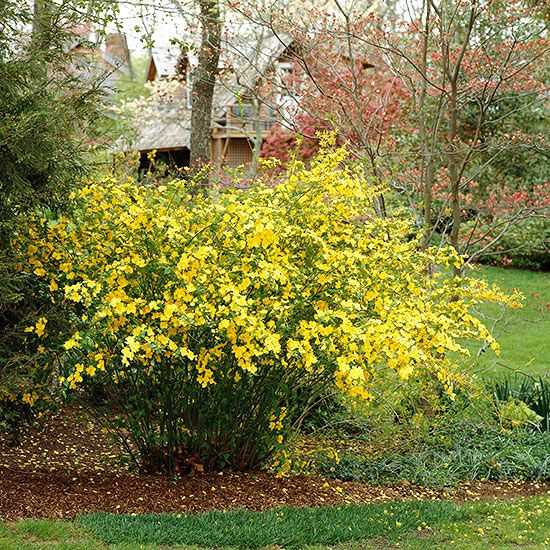
Introduction
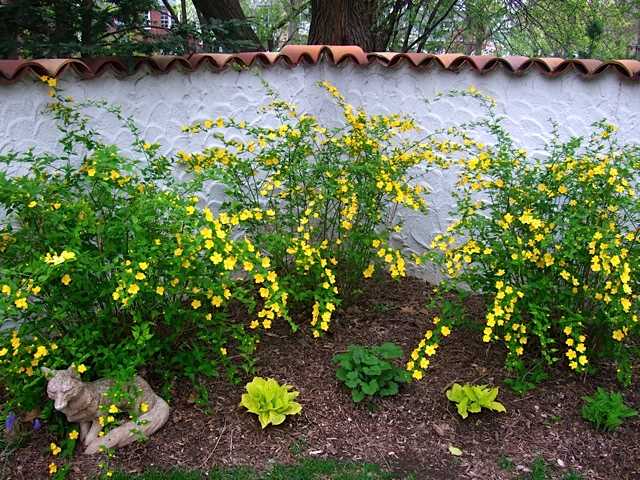
Kerria is a beautiful flowering shrub that can add a pop of color to any garden. It is easy to grow and maintain, making it a popular choice among gardeners. In this article, we will explore the different types and varieties of Kerria and provide tips on how to grow them successfully.
Types of Kerria
There are two main types of Kerria: Kerria japonica and Kerria japonica ‘Pleniflora’.
Kerria japonica
Kerria japonica, also known as Japanese kerria or simply kerria, is a deciduous shrub that can reach a height of 3-5 feet. It produces bright yellow flowers in the spring, which last for several weeks. The foliage is green and can add a touch of elegance to any garden.
This type of Kerria is very hardy and can tolerate a wide range of growing conditions. It prefers partial shade but can also tolerate full sun. It is also tolerant of a variety of soil types, making it suitable for different regions.
Kerria japonica ‘Pleniflora’
Kerria japonica ‘Pleniflora’, also known as double-flowered kerria or double kerria, is a cultivar of Kerria japonica. It is characterized by its double-petaled flowers, which give it a unique and beautiful appearance. The flowers are a vibrant yellow and can add a splash of color to any garden.
Like Kerria japonica, this variety is very hardy and can tolerate a variety of growing conditions. It prefers partial shade but can also tolerate full sun. It is a great choice for adding a touch of whimsy and charm to your garden.
How to Grow Kerria
Here are some tips on how to grow Kerria successfully:
- Choose a suitable location: Kerria prefers partial shade but can tolerate full sun. Choose a location that receives at least a few hours of direct sunlight each day.
- Prepare the soil: Kerria can tolerate a variety of soil types, but it prefers well-draining soil. Amend heavy clay soil with organic matter to improve drainage.
- Plant the shrub: Dig a hole that is slightly larger than the root ball of the shrub. Place the shrub in the hole and backfill with soil, firming it gently around the roots.
- Water regularly: Kerria prefers moist soil, so water the shrub regularly, especially during dry periods. Avoid overwatering, as this can lead to root rot.
- Prune as needed: Kerria can be pruned after flowering to maintain its shape and remove any dead or damaged branches.
Conclusion
Kerria is a versatile and beautiful shrub that can add a splash of color to any garden. With its easy-to-grow nature and hardiness, it is a great choice for both beginner and experienced gardeners. Whether you choose the classic Kerria japonica or the unique Kerria japonica ‘Pleniflora’, you are sure to enjoy the beauty and charm these plants bring to your outdoor space.
Benefits of Growing Kerria
Kerria is a versatile plant that offers several benefits to the garden and to gardeners. Here are some of the key benefits of growing Kerria:
Easy to grow: Kerria is a low-maintenance plant that is easy to grow, making it a great choice for beginners or busy gardeners. It can tolerate a wide range of soil types and growing conditions, including both full sun and partial shade.
Beautiful blooms: Kerria produces stunning bright yellow flowers that add a pop of color to any garden. The flowers are typically large and showy, attracting pollinators such as bees and butterflies.
Long bloom period: The blooming season of Kerria extends for several weeks, providing an extended period of beauty in the garden. This makes it a great choice for creating a focal point or adding interest to an otherwise dull area.
Drought tolerant: Once established, Kerria is fairly drought tolerant and can survive periods of dry weather without needing much supplemental watering. This can be a valuable attribute in regions with limited water resources or during summer months when water restrictions may be in place.
Attractive foliage: In addition to its beautiful flowers, Kerria also features attractive green foliage that lasts throughout the growing season. The leaves are typically heart-shaped and add a lush, green backdrop to the blooms.
Low maintenance: Kerria requires minimal care once it is established. It is generally pest and disease resistant, reducing the need for frequent treatments or interventions. Pruning is usually only necessary to maintain the desired shape or to remove any dead or damaged wood.
Wildlife-friendly: The flowers of Kerria attract pollinators, such as bees and butterflies, which help to pollinate other plants in the garden. The plant also provides shelter and habitat for small wildlife, such as birds or insects, adding biodiversity to the garden ecosystem.
Overall, growing Kerria can enhance the beauty of your garden while requiring minimal effort and maintenance. Whether you are a beginner gardener or an experienced one, this versatile plant is sure to bring joy and color to your outdoor space.
Types of Kerria
Kerria is a beautiful flowering plant that belongs to the Rosaceae family. There are two main types of Kerria that are commonly found in gardens:
1. Kerria japonica (Japanese Kerria)
Kerria japonica is the most widely cultivated variety of Kerria. It features single or double, golden yellow flowers that bloom in spring. The flowers are usually 1-2 inches in diameter and have a simple, yet charming appearance. The foliage is bright green and provides an attractive backdrop for the flowers.
Japanese Kerria is a deciduous shrub that can grow up to 6 feet tall and wide. It has a rounded, spreading habit which adds volume and texture to garden landscapes. This variety is known for its ability to tolerate a wide range of soil conditions and is generally low-maintenance.
2. Kerria japonica ‘Pleniflora’ (Double-flowered Kerria)
Kerria japonica ‘Pleniflora’, also known as Double-flowered Kerria or Japanese rose, is a cultivar of Kerria japonica. It is highly prized for its showy double flowers, which resemble pompoms and add a touch of elegance to any garden. The flowers bloom abundantly in late spring and can last for several weeks.
The foliage of Double-flowered Kerria is the same as that of the Japanese Kerria, with bright green leaves that provide a lush backdrop for the flowers. This variety has a similar growth habit and can reach a similar size as the Japanese Kerria.
Both the Japanese Kerria and Double-flowered Kerria are excellent choices for adding color and interest to gardens. They can be grown as focal points or used to create beautiful hedges or borders. With their vibrant flowers and easy-care nature, Kerria plants are a wonderful addition to any garden.
Variegated Kerria Varieties
Kerria is a genus of flowering plants in the Rosaceae family. The most common species, Kerria japonica, is known for its bright yellow flowers that bloom in spring. However, there are also variegated varieties of Kerria that add a unique and visually appealing element to the garden.
1. Kerria japonica ‘Picta’
Kerria japonica ‘Picta’ is a variegated cultivar of the species. Its foliage has creamy white edges, creating a striking contrast with its green center. The yellow flowers of ‘Picta’ are a beautiful complement to the variegated leaves.
2. Kerria japonica ‘Goldflame’
Kerria japonica ‘Goldflame’ is another variegated variety of Kerria. Its leaves are variegated with yellow and green, adding a splash of color to the garden. ‘Goldflame’ also produces yellow flowers, providing a consistent color scheme throughout the plant.
3. Kerria japonica ‘Albocerea’
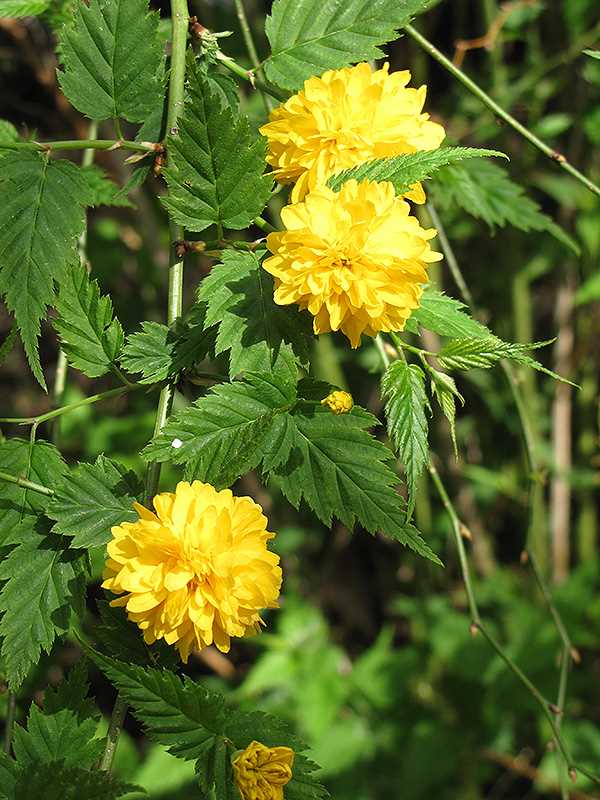
Kerria japonica ‘Albocerea’ is a rare variegated cultivar with white-edged leaves. The variegated foliage of ‘Albocerea’ creates an interesting texture and adds a touch of elegance to the garden. Like other Kerria varieties, ‘Albocerea’ produces yellow flowers.
4. Kerria japonica ‘Variegata’
Kerria japonica ‘Variegata’ is a variegated form of the species that features green leaves with creamy white margins. The variegation adds a vibrant touch to the plant, making it a standout in the garden. ‘Variegata’ also produces the characteristic yellow flowers of Kerria.
5. Kerria japonica ‘Albovariegata’
Kerria japonica ‘Albovariegata’ is a variegated variety with green leaves bordered by white edges. The variegation creates a fresh and eye-catching look, enhancing the overall aesthetic of the plant. ‘Albovariegata’ also produces yellow flowers.
These variegated Kerria varieties offer a unique twist to the traditional yellow-flowered species. Their variegated foliage adds visual interest and enhances the overall beauty of the garden. Consider adding these stunning plants to your garden to enjoy their unique charm.
Dwarf Kerria Varieties
Kerria is a beautiful flowering shrub that can add color and interest to your garden. While most varieties of kerria can grow quite tall, there are also dwarf varieties available that are perfect for smaller gardens or container planting. Here are some popular dwarf kerria varieties:
1. ‘Picta’
The ‘Picta’ variety of kerria is a compact shrub that typically grows to a height of 2-4 feet. It has bright green foliage with yellow and green variegation, adding a touch of color to your garden. This variety also produces lovely yellow flowers in the spring.
2. ‘Pleniflora Nana’
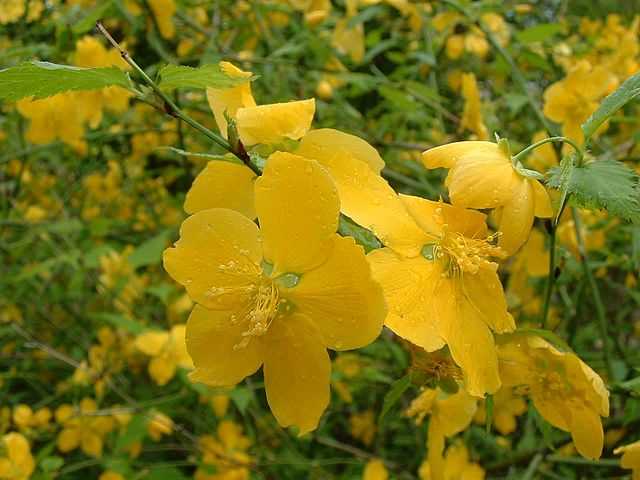
‘Pleniflora Nana’ is a dwarf variety of kerria that has double-flower blooms. It grows to a height of 2-3 feet with an equal spread. The flowers are a vibrant yellow color and appear in abundance during the spring and early summer.
3. ‘Golden Guinea’
The ‘Golden Guinea’ variety of kerria is a dwarf cultivar that reaches a height of 2-3 feet. It has bright green foliage and produces large, double-flower blooms in a golden yellow color. This variety is known for its long-lasting blooms, providing a cheerful display in your garden.
4. ‘Japanensis’
‘Japanensis’ is another dwarf kerria variety that grows to a height of about 2-3 feet. It has green foliage and produces bright yellow flowers in the spring. This variety is also known for its ability to tolerate shade, making it a great choice for gardens with less sunlight.
5. ‘Mikazuki’
‘Mikazuki’ is a low-growing dwarf kerria variety that reaches a height of around 1-2 feet. It has green foliage with a white variegation, adding a unique touch to your garden. This variety also produces small, yellow flowers in the spring.
These dwarf kerria varieties are just a few examples of the many options available to gardeners. Whether you have a small garden or want to add some color to your containers, these compact kerria varieties are a great choice.
Planting and Care Tips for Kerria
Planting Kerria
When planting Kerria in your garden, follow these tips for successful growth:
- Choose a location that receives partial shade or dappled sunlight. Kerria can also tolerate full sun, but it prefers some shade during the hottest part of the day.
- Ensure the soil is well-draining and rich in organic matter.
- Dig a hole that is twice as wide and just as deep as the root ball of the Kerria plant.
- Gently remove the Kerria plant from its container and place it in the hole, ensuring that the top of the root ball is level with the soil surface.
- Backfill the hole with soil, firming it gently around the roots.
- Water the newly planted Kerria thoroughly to help it settle into its new location.
Caring for Kerria
Once your Kerria is planted, follow these care tips to keep it healthy and thriving:
- Water your Kerria regularly, especially during dry periods. The soil should be kept consistently moist, but not soggy.
- Apply a layer of mulch around the base of the plant to help conserve moisture and suppress weed growth.
- Prune your Kerria after it finishes flowering to maintain its shape and promote new growth. Remove any dead, damaged, or crossing branches.
- Fertilize your Kerria in early spring with a balanced, slow-release fertilizer. Follow the instructions on the fertilizer packaging for proper application.
- Monitor your Kerria for signs of pests or diseases, such as aphids or powdery mildew. Treat any issues promptly to prevent them from spreading.
By following these planting and care tips, you can enjoy a beautiful and healthy Kerria plant in your garden.
Common Pests and Diseases of Kerria
Pests
Kerria plants are generally resistant to pests, but they may still be affected by a few common garden pests. Here are some pests to be aware of:
- Aphids: These small insects feed on the sap of the plant and can cause leaves to become distorted and discolored. Aphids can be removed by spraying the plant with a strong jet of water or treated with insecticidal soap.
- Scale insects: These insects are small, flat, and usually brown or black. They attach themselves to the stems and leaves of the plant and suck out the sap. Scale insects can be controlled by removing them manually or treating with horticultural oil.
- Caterpillars: Some caterpillars may chew on the leaves of Kerria plants. Handpicking them or using an appropriate insecticide can help control their population.
Diseases
Kerria plants are generally hardy and resistant to many diseases. However, they can still be susceptible to a few common diseases. Here are some diseases to watch out for:
- Powdery mildew: This fungal disease causes a white powdery coating on the leaves. It can be controlled by improving air circulation around the plant, avoiding overhead watering, and treating with a fungicide if necessary.
- Leaf spot: Leaf spot is a fungal disease that causes dark spots on the leaves. It can be prevented by avoiding overhead watering and removing affected leaves. Fungicidal sprays may also be used to control the disease.
- Crown gall: Crown gall is a bacterial disease that causes swollen and distorted growths on the stems and roots of the plant. There is no cure for crown gall, so prevention and removal of infected plants is the best approach.
By being aware of these pests and diseases, and taking appropriate measures to prevent and control them, you can ensure the health and beauty of your Kerria plants.
Kerria in Landscape Design
Kerria is a versatile plant that can be used in various ways to enhance the beauty of a garden or landscape. Its vibrant yellow flowers and arching stems make it a standout feature in any design.
Border Plant
Kerria can be planted along borders to create a natural, vibrant edge to any garden or landscape. Its dense growth and arching stems provide a beautiful backdrop for other plants and flowers.
Foundation Planting
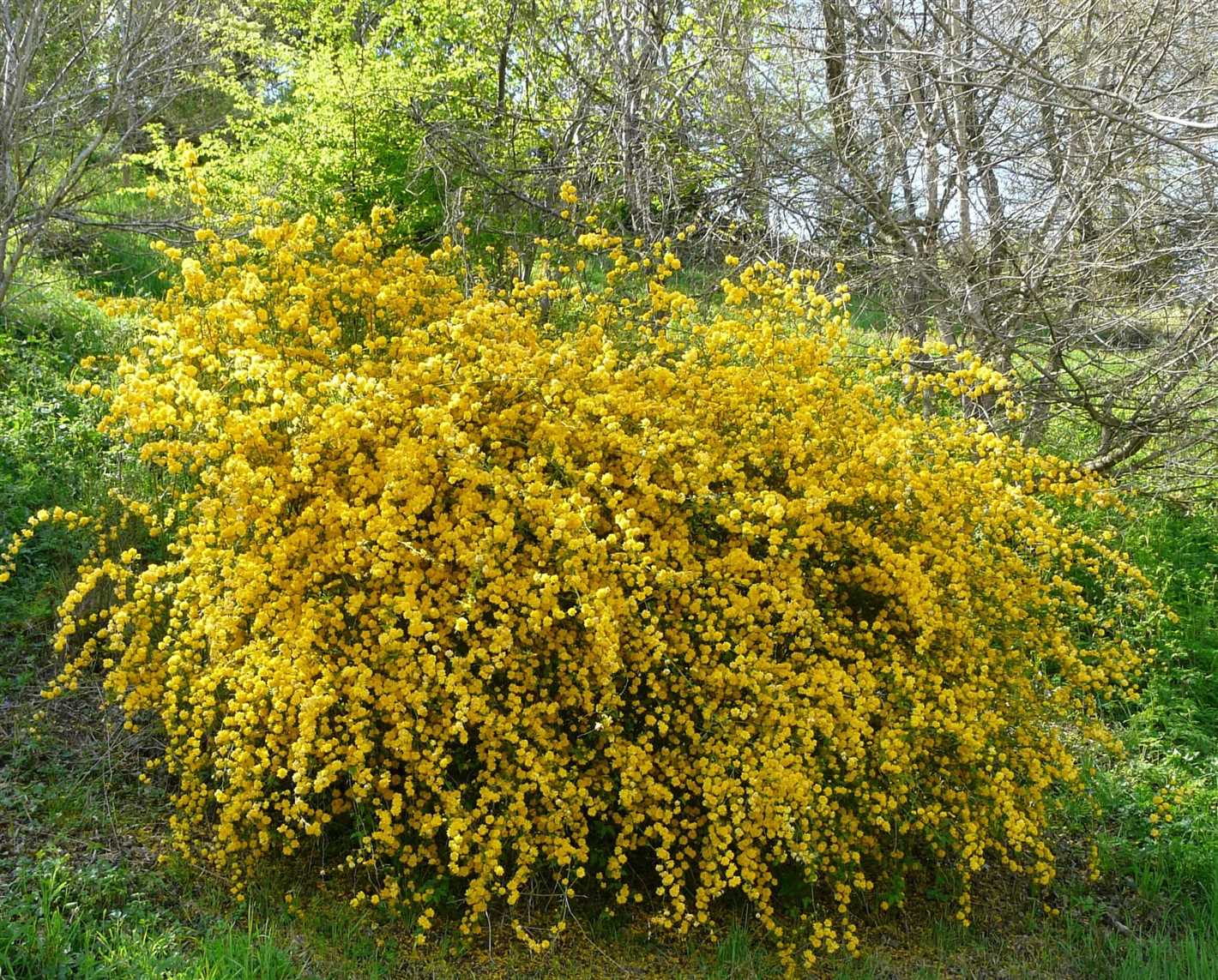
The compact nature of Kerria makes it an excellent choice for foundation plantings. It can be planted next to the walls of a building to soften the hard lines and add a touch of color with its bright yellow flowers.
Mass Planting
Kerria can also be used in mass plantings to create a stunning visual impact. Whether used as a groundcover or planted in groups, its bright flowers are sure to catch the eye and create a beautiful display.
Container Planting
If you have limited space or want to add some color to a patio or balcony, Kerria can be planted in containers. Its compact growth habit and arching stems make it a beautiful addition to any container garden.
Combination Plantings
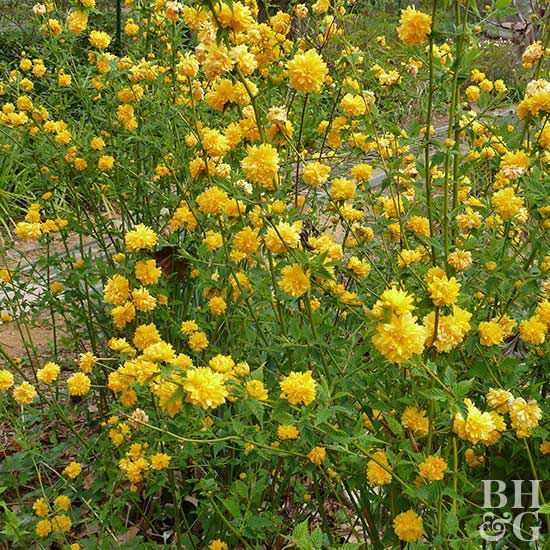
Kerria can be combined with other plants and flowers to create beautiful combinations. Its yellow flowers can be paired with purple or blue flowers for a striking contrast, or with pink or white flowers for a softer, more romantic look.
Low Maintenance
One of the benefits of Kerria in landscape design is its low maintenance requirements. It is a hardy plant that can tolerate a wide range of soil conditions and is relatively pest and disease-resistant. This makes it an excellent choice for beginners or those with limited time for gardening.
Conclusion
Whether used as a border plant, foundation planting, mass planting, container plant, or as part of a combination planting, Kerria can add beauty and color to any garden or landscape. Its bright yellow flowers and arching stems make it a standout feature that is sure to attract attention. With its low maintenance requirements, it is a versatile plant that can be enjoyed by both experienced gardeners and beginners alike.
Your Website Name
About Kerria
Kernia is a genus of flowering plants in the Rosaceae family. It is native to Asia and is commonly grown in gardens for its beautiful flowers. There are several species and varieties of kerria, each with its own unique characteristics and growing requirements.
Growing Kerria in the Garden
Kerria is a versatile plant that can thrive in various garden settings. It is best grown in well-drained soil and prefers partial shade to full sun. The plant is relatively low-maintenance and can tolerate a wide range of soil conditions.
To grow kerria in your garden, follow these simple steps:
Choose a location that receives partial shade to full sun.
Prepare the soil by loosening it and removing any weeds or debris.
Dig a hole that is slightly larger than the root ball of the kerria plant.
Place the plant in the hole, ensuring that the top of the root ball is level with the soil surface.
Backfill the hole with soil and gently pat it down to remove any air pockets.
Water the plant thoroughly after planting and keep the soil moist but not waterlogged.
Mulch around the base of the plant to conserve moisture and prevent weed growth.
Prune the kerria plant in early spring to maintain its shape and remove any dead or damaged branches.
Types and Varieties of Kerria
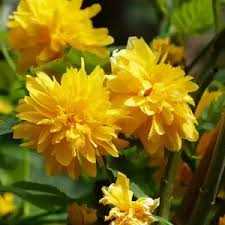
The most common variety of kerria is Kerria japonica, also known as Japanese rose. It is a deciduous shrub that produces bright yellow flowers in spring. There are also double-flowered varieties available, which have a more ornamental appearance.
Other species of kerria include Kerria sinensis and Kerria japonica ‘Pleniflora’. Kerria sinensis is native to China and produces orange-yellow flowers. Kerria japonica ‘Pleniflora’ is a double-flowered variety that features clusters of pom-pom-like flowers.
Conclusion
Kerria is a beautiful flowering plant that can add color and charm to any garden. With its low-maintenance nature and ability to thrive in various conditions, kerria is a popular choice among gardeners. Whether you choose the Japanese rose or one of its other varieties, kerria is sure to brighten up your garden.
Questions and Answers:
What is kerria?
Kerria is a deciduous flowering shrub native to China and Japan. It is known for its bright yellow, rose-like flowers and green foliage.
What are the different types of kerria?
The two main types of kerria are Kerria japonica and Kerria japonica ‘Pleniflora’. Kerria japonica has single, five-petaled flowers, while Kerria japonica ‘Pleniflora’ has double flowers.
How tall does kerria grow?
Kerria shrubs typically grow to be around 3 to 6 feet tall and wide. However, some varieties may grow taller or wider.
How do I care for kerria plants?
Kerria plants prefer to be grown in full sun to partial shade and well-drained soil. They are relatively low-maintenance and only require occasional pruning to maintain their shape.
Can I grow kerria in containers?
While kerria can be grown in containers, it is best suited for growing in the ground. If you do choose to grow kerria in a container, make sure to select a large enough pot to accommodate its mature size.
When do kerria plants bloom?
Kerria plants typically bloom in the spring, producing their bright yellow flowers. Some varieties may also produce a second flush of blooms in the fall.
Are kerria plants deer resistant?
Kerria plants are generally considered to be deer resistant, meaning that they are less likely to be damaged or eaten by deer. However, it is always a good idea to take precautions if you live in an area with a high deer population.







